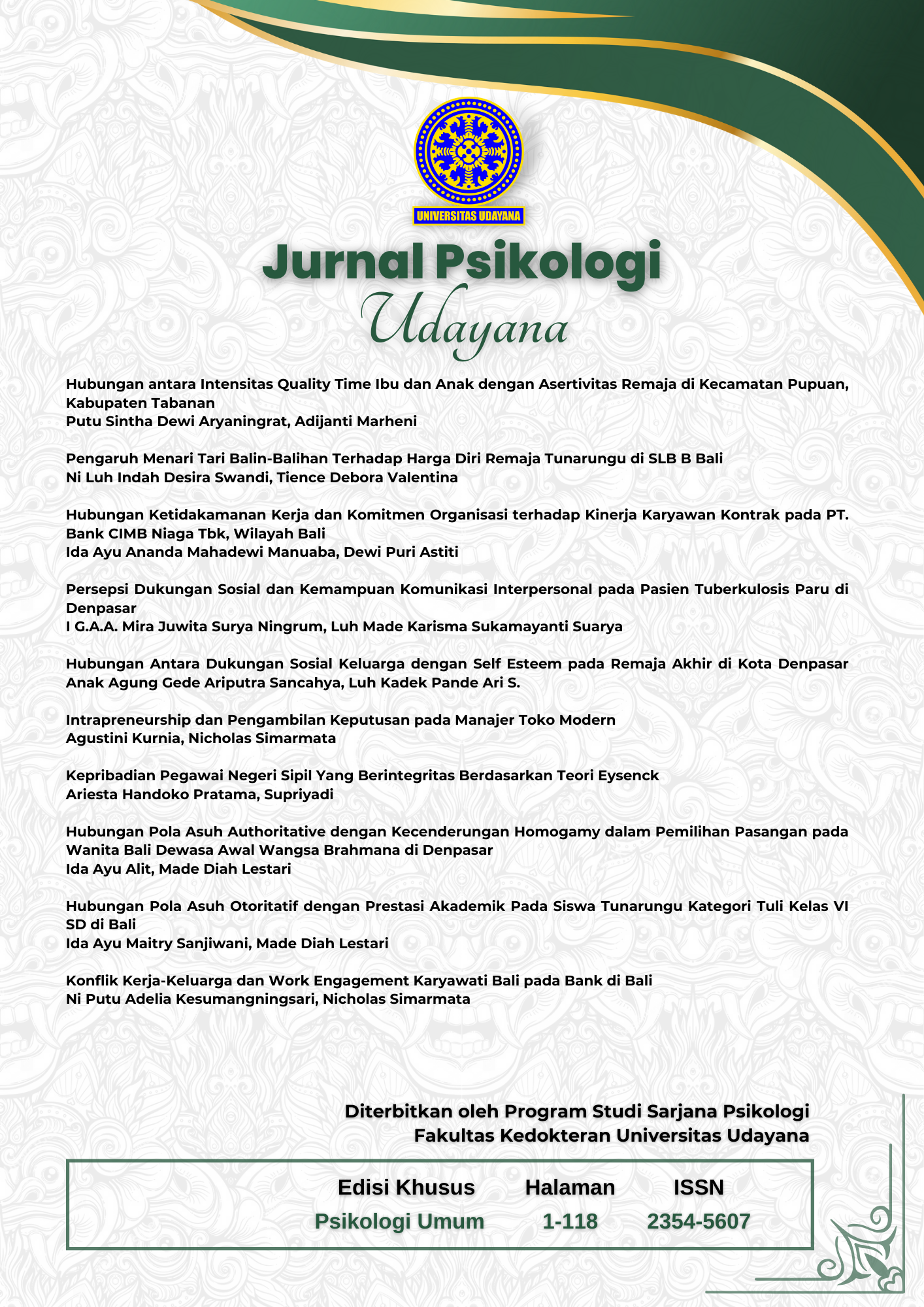HUBUNGAN ANTARA DUKUNGAN SOSIAL KELUARGA DENGAN SELF ESTEEM PADA REMAJA AKHIR DI KOTA DENPASAR
Abstract
Adolescent development toward the adult stage is always in touch with the family in every aspect. One aspect is the development of adolescent self-esteem. Self esteem is one of the aspects that support the development of adolescents to be able to develop optimally and determine success in adulthood. Adolescents need the support of the family to be able to develop self-esteem because the family is the first social environment where adolescents develop. Therefore, researchers assume that there is a relationship between family social support with self-esteem in adolescents in the city of Denpasar.
This research method is quantitative correlation where the number of the subject in Denpasar 408 teenagers whose age 17-19 years . Methods of data collection is family social support scale and the scale of self esteem . Reliability of family social support scale is 0.943 and self esteem scale reliability is 0.940 . Normality of families social support variable is 0,219 and self-esteem variables normality is 0.572 . Linearity between family social support variables and self esteem is 0,000 . The coefficient of determination ( r2 ) 0.268 . Methods of data analysis is a technique of regression. The correlation coefficient is 0.518 with a probability of 0.000 . It is proved that there is a correlation between social support families with self-esteem in adolescents in the city of Denpasar.
Keywords: family social support, self esteem, adolescents
Downloads
References
Azwar, S. 2012. Penyusunan Skala Psikologi. Yogyakarta: Pustaka Pelajar.
Azwar, S. 2013. Metode Penelitian. Yogyakarta: Pustaka Pelajar.
Baldwin, Scott A., & John P. Hoffmann. 2002. The Dynamic of Self Esteem. Journal of Youth and Adolescence, Vol. 21, No. 2, April 2002 by Kluwer Academic Publishers.
Baron, R. A & Bryne, D. 2000. Psikologi Sosial. Alih Bahasa: Michael Adriyanto. Jakarta: Raja Grafindo.
Calhoun, J.F. Acocella, J.R. 1990. Psikologi tentang Penyesuaian dan Hubungan Kemanusiaan. Alih bahasa: Satmoko: IKIP Semarang Press.
Centi, P.J. 1995. Mengapa Rendah Diri. Yogyakarta: Kanisius.
Coopersmith, S. 1967. The Antecedents of Self Esteem. San Fransisco : W.H. Freeman.Company.
Duffy, K. G. & F. Y. Wong. 2003. Community Psychology (3rd edition). United states of America: Pearson Education, Inc.
Harlyan, L. I. 2012. Uji Hipotesis. Departemen Sumber Daya Perikanan Universitas Brawijaya. Akses:23 April 2013,
http://ledhyane.lecture.ub.ac.id/files/2012/11/PENGUJIAN-HIPOTESIS.pdf
Hasan, Iqbal. 2005. Pokok-Pokok Materi Statistik 2 (Statistik Inferensif). Jakarta: Bumi Aksara.
Heatherton, Todd F., dan Carrie L. Wyland. 2003. Positive Psychological Assesment: A Handbook of Models and Measures.Washington, DC, US: American Psychological Association
Hurlock, E. B. 2002. Psikologi Perkembangan, Suatu Pendekatan Sepanjang Rentang Kehidupan. Jakarta: Airlangga.
Johnson. D. W, Johnson F. (1991). Joining Together. Group and Group Skill. Fouth Edition. Englewood Cliffts. Prentice Hall Inc.
Kail, R.V. & Cavanaugh, J.C. 2000. Human Development: A Life Span View (2nd ed.). Canada: Wadsworth &Thompson Learning.
Lestari, Sri. 2012. Psikologi Keluarga: Penanaman Nilai dan Penanganan Konflik dalam Keluarga. Jakarta: Kencana Prenada Media Group.
Majalah Intisari edisi 598. Berjuang Dari Titik Nol. Jakarta: Gramedia Majalah
Makmun, Abin Syamsudin. 2007. Psikologi Kependidikan, Perangkat Sistem Pengajaran Modul. Bandung: PT Remaja Rosdakarya.
Orford, J. 1992. Community Psychology: Theory and Practice. England: John Wiley & Sons.
Papalia, Diane E., Sally Wendkos Olds, & Ruth Duskin Feldman. 2009. Human Development, edisi 10, buku 2. Jakarta: Salemba Humanika.
Santrock, J. W. 2003. Adolescence (Perkembangan Remaja). Terjemahan oleh Soedjarwo. Jakarta: Penerbit Erlangga.
Sarafino, E.P . 2002. Health Psychology: Biopsychosocial Interaction (4th ed.). New York: John Wiley.
Sarwono, Sarlito W. 2012. Psikologi Remaja. Jakarta: Rajawali Press.
Shore, Kenneth. 2007. The Student with Low Self Esteem Available at: http://www.education-world.com/a_curr/shore/shore059.shtml (Diakses 1 Maret 2013)
Sugiyono. 2009. MetodelogiPenelitian Bisnis. Bandung: CV Alfabeta.
Sugiyono. 2010. Statistika untuk Penelitian. Bandung: CV Alfabeta.
Sunyoto, Danang. 2011. Analisis Regresi dan Uji Hipotesis. Yogyakarta: CAPS.
Suryabrata, Sumadi. 1999. Pengembangan Alat Ukur Psikologis. Jakarta: Direktorat Jenderal Pendidikan Tinggi Departemen Pendidikan dan Kebudayaan.
Surono, Agus. 2012. Pilot Wanita Tanpa Tangan. www.intisari-online.com diakses pada 27 Juni 2013
Syam, Nur. 2012. Peran Generasi Muda Bagi Bangsanya Available at: http://nursyam.sunan-ampel.ac.id/?p=115 (Diakses 16 Maret 2013).
Trzesniewski, Kali H., M. Brent Donnellan, Terrie E. Moffitt, Richard W. Robins, Richie Poulton, & Avshalom Caspi. 2006. Low Self Esteem During Adolescence Predicts Poor health, Criminal behavior, and Limited Economic Prospects During Adulthood. Journal of developmental Psychology Vol. 42, No. 2, 381-390. Copyright 2006 by the American Psychological Association.
United Nation Development Program (UNDP). 2011. Human Development Report 2011 Sustainability and Equity: A Better Future for All Available at: http://hdr.undp.org/en/reports/global/hdr2011/ (Diakses 16 Maret 2011)
Utari, Rahmania. 2007. Upaya Sekolah Dalam Pembentukan Self Esteem Siswa Melalui Pembelajaran. Dinamika pendidikan No.1 /Th. XIV/Mei 2007.
Widanarti, Niken, dan Aisah Indati. 2002. Hubungan Antara Dukungan Sosial Keluarga Dengan Self-Efficacy pada Remaja di SMU Negeri 9 Yogyakarta. Yogyakarta: Jurnal Psikologi Fakultas Psikologi UGM No.2, 112-123.
Zainuddin, M. 2000. Metodelogi Penelitian. Diktat
Authors who publish with this journal agree to the following terms:
- Authors retain copyright and grant the journal right of first publication with the work simultaneously licensed under a Creative Commons Attribution-ShareAlike 4.0 International License that allows others to share the work with an acknowledgement of the works authorship and initial publication in this journal.
- Authors are able to enter into separate, additional contractual arrangements for the non-exclusive distribution of the journals published version of the work (e.g., post it to an institutional repository or publish it in a book), with an acknowledgement of its initial publication in this journal.
- Authors are permitted and encouraged to post their work online (e.g., in institutional repositories or on their website) prior to and during the submission process, as it can lead to productive exchanges, as well as earlier and greater citation of published work (See The Effect of Open Access).













